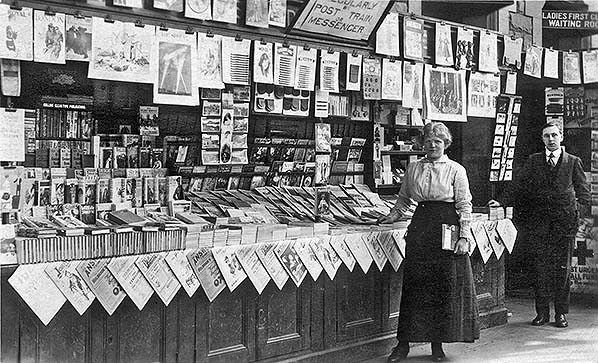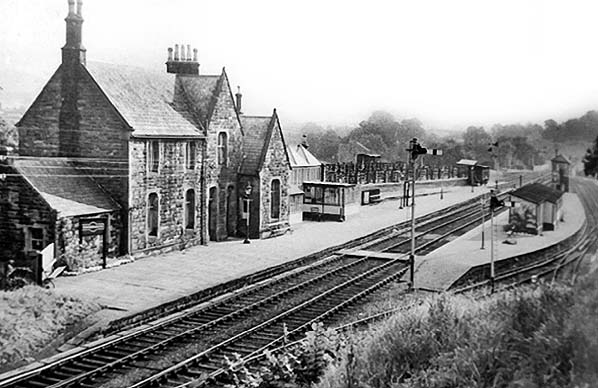
[Source: Alan Young] Cockermouth Station Gallery 2: pre-1914 - c.1960  The counter and staff in Cockermouth station’s refreshment room probably shortly before World War 1. Thirsty passengers may avail themselves of a ‘specially prepared’ cup of tea for 2d and an alluring range of cakes is displayed under glass domes.
Copyright photo from John Alsop collection 
An exquisite study of the bookstall at Cockermouth station in 1916. The clarity of the photograph enables us to see the range of books, magazines, picture postcards and stationery offered to passengers. ‘Railway Magazine’ Edition 225 of March 1916 is on the stall and ‘The Sphere’, which ran a series of articles on Zeppelin raids, is for sale; its edition of 5 March 1916 seen here covers the operation of searchlights. Extraordinary care has been taken with preparing the display. (Thanks to Darren Kitson for researching this information from the Railway Magazine and British
Newspaper archives.) Copyright photo from John Alsop collection

Cockermouth station staff assembled at the entrance c1918. Standing, L-R: An unidentified tall figure wearing traditional CK&P jacket and green corduroy trousers and prominent CJS (Cockermouth Joint Station) lapel badges; An S&T inspector (with bowler); T Armstrong (porter from 1901); John Vickers (in service since 1900); Robert Little (Stationmaster 1891-1921; A tall porter; Mark Allinson (signalman); Thomas Arthur Ridley; Jack Stanley (signalman). Kneeling, L-R: Son of Reg Litt; Reg Litt; Bill Hartley; Percy Sanderson (Clerk).
Photo from Syd Ridley Jr and John Mann collections 
Looking south-east towards Cockermouth station from Station Road bridge in 1931. The tank in the foreground supplied the engine shed behind the down platform where locomotives would have been watered. The adjacent carriage shed can just be made out next to the signal on the right. The station's turntable is hidden from view by the tank. The locomotive standing at the down platform is a Webb 2-4-2T and possibly of the 4ft 6in variant; the picture quality does not allow more detailed identification. Note the cattle wagons in the siding behind the up platform.
Photo from GC Lewthwaite collection  On 7 August 1950 ‘Cauliflower’ 0-6-0 No.28589 is drawing away from the down (island) platform of Cockermouth station with the 10.20am Penrith to Workington (Main) train. The refreshment room, closed in the 1930s, has been demolished. The first three carriages are ex LMS local, non-corridor, stock from the Stanier era. The brake is the third vehicle and appears to be to a slightly earlier design but still from the Stanier era. The fourth vehicle is unclear and has a look of LNWR about it. The fact that it is coupled behind the brake suggests that it has been tagged on to provide extra accommodation. The locomotive is one of those to survive into BR days but she was to never carry her allocated BR number, 58421.
Photo by E S Russell 
Cockermouth station is seen in 1955 looking south-east over the forecourt. The Gothic stone-built structure with its varied building line, gables and glazed canopy sheltering the entrance is extremely handsome. It is a pity that no use would be found for the buildings after closure and demolition
would follow. Photo
by D Jenkinson

Cockermouth station looking north-east from Station Road bridge in 1955. This appears to have been the only station on the CK&P to have been fitted with LMS ‘Hawkeye’ nameboards, one of which is displayed in front of the near-end single-storey section of the building. It is placed diagonally to the line of the platform as was sometimes the practice to allow it to be more easily read by passengers on trains arriving at that platform (unless they were seated facing backwards)!
Photo from John Mann collection  When the first Cockermouth station opened in 1847 it was provided with a two-road engine shed and turntable. When the station closed to passengers in 1865 and became a goods station the engine shed was extended for use as a good shed. The new station was provided with a long single-road engine shed, a two-road carriage shed and a XXft turntable, all reached from the island platform loop. The engine shed remained in use until 19XX but the turntable survived until closure of the line. The turntable is seen here in the 1950s as is the tank which supplied water for the engine shed.
Photo from James Lake collection 
In August 1955 Ivatt Class 2F 0-6-0 No.46488 is seen at Cockermouth station’s up platform bound for Keswick and Penrith. The station building appears beyond the carriages. A modest timber waiting shed is seen on the down (island) platform. The locomotive was built in 1951 and spent its life at 12D, Workington shed until it was withdrawn in 1965 only months before the line through Cockermouth closed. There would appear to be railway enthusiasts present – see the heads protruding from carriage windows - no doubt to witness what was thought, falsely as it turned out, to be the end of steam on the line. The rolling stock is all of ex LMS Stanier origin. The first three are wearing the 1948-56 Carmine & Cream (unofficially Blood & Custard or Plum & Spilt milk) livery and this tells us that the first three vehicles are corridor stock. The brake is the vehicle immediately behind the locomotive (note the fireman atop the tender with his shovel - he would be shifting coal forward). The last two vehicles are again ex LMS but are wearing Crimson Lake livery, which latter tells us they are non-corridor types. Crimson Lake was a shade of red used by the LMS for its local stock and was perpetuated for a time by BR for certain non-corridor loco-hauled stock until replaced by the 1956 maroon livery and in a few instances by BR Rail Blue.
Photo copyright ColourRail  Cockermouth station is seen in September 1959, looking west on the island platform. The ‘Derby Lightweight’ diesel multiple units were introduced on the Penrith – Workington route in January 1955, and one of these stands at the platform carrying the ‘whiskers’ design above the buffers.
Photo from John Mann collection  Station staff pose below the LMS 'Hawkseye' sign at the west end of the up platform. They are from L - R Billy Hartley, Richard Sanderson and Philys Williams. The other two are unknown. Photo from Barbara Scales Click here for Cockermouth Station Gallery 3:
|


 Home Page
Home Page